Jupiter is in the news again, this time because its "Baby Red Spot" - a storm less than a year old - appears to have been swallowed up by the massive storm known as the Great Red Spot. This is good occasion to share some of the best photographs of Jupiter and its larger system of rings and moons, as seen by various probes and telescopes over the past 30 years.
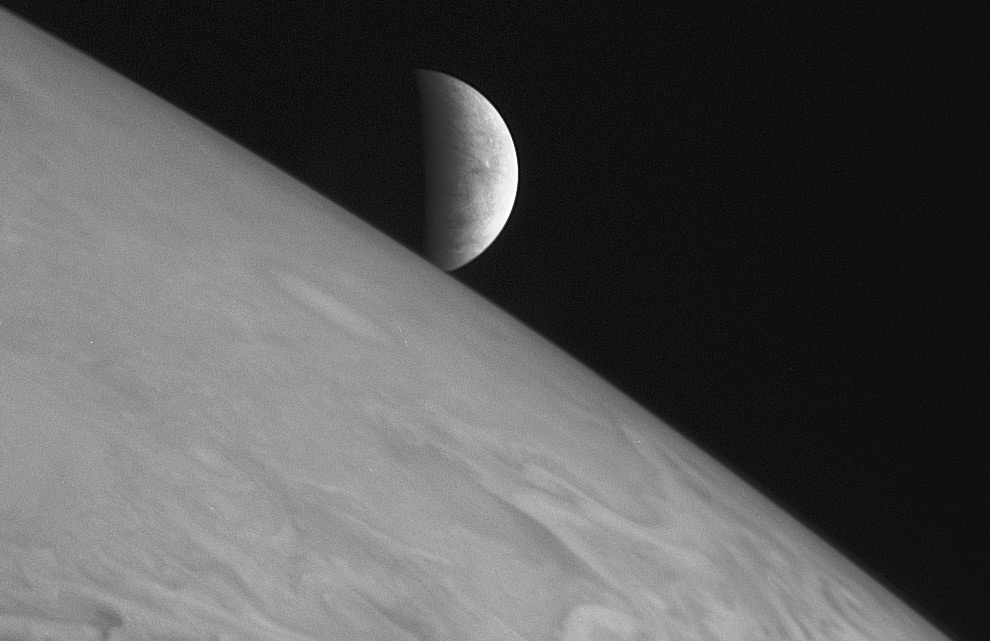
This image of Jupiter's moon Europa rising above Jupiter was captured by the New Horizons spacecraft in February just after it passed Jupiter on its way to Pluto and the outer Solar System. (NASA, Johns Hopkins U. APL, SWRI)
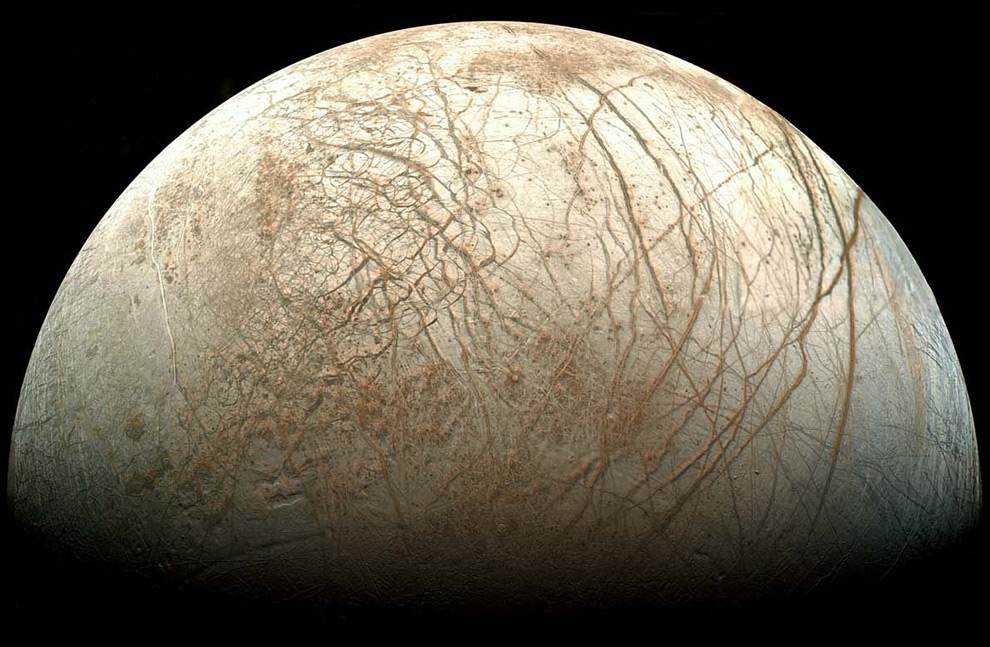
The gibbous phase of Jupiter's moon Europa. The robot spacecraft Galileo captured this image mosaic during its mission orbiting Jupiter from 1995 - 2003. Evidence and images from the Galileo spacecraft, indicated that liquid oceans might exist below the icy surface. (Galileo Project, JPL, NASA; reprocessed by Ted Stryk)
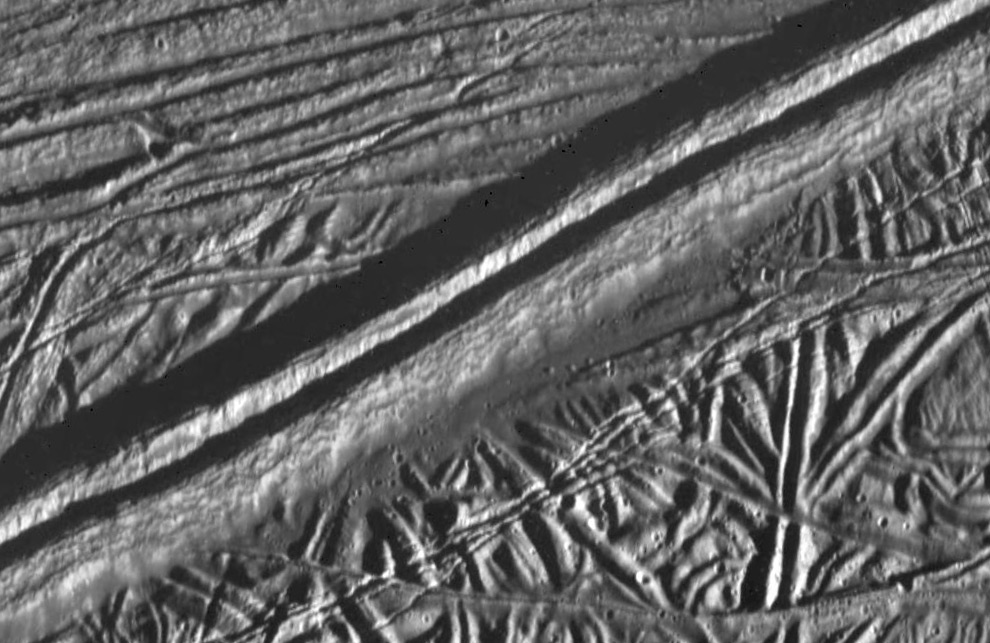
This view of the icy surface of Jupiter's moon, Europa, is a mosaic of two pictures taken by the Solid State Imaging system on board the Galileo spacecraft during a close flyby of Europa on February 20, 1997. The area shown is about 14 kilometers by 17 kilometers (8.7 miles by 10.6 miles), and has a resolution of 20 meters (22 yards) per pixel. One of the youngest features seen in this area is the double ridge cutting across the picture from the lower left to the upper right. This double ridge is about 2.6 kilometers (1.6 miles) wide and stands some 300 meters (330 yards) high. (NASA/JPL/ASU)

A composite of several images taken in several colors by the New Horizons Multispectral Visual Imaging Camera, or MVIC, illustrating the diversity of structures in Jupiter's atmosphere, in colors similar to what someone "riding" on New Horizons would see. It was taken near the terminator, the boundary between day and night, and shows relatively small-scale, turbulent, whirlpool-like structures near the south pole of the planet. The dark "holes" in this region are actually places where there is very little cloud cover, so sunlight is not reflected back to the camera. (NASA/Johns Hopkins University Applied Physics Laboratory/Southwest Research Institute)

This image, acquired during Galileo's ninth orbit around Jupiter, shows two volcanic plumes on Io. One plume was captured on the bright limb or edge of the moon, erupting over a caldera (volcanic depression) named Pillan Patera. The plume seen by Galileo is 140 kilometers (86 miles) high, and was also detected by the Hubble Space Telescope. The second plume, seen near the terminator, the boundary between day and night, is called Prometheus. The shadow of the airborne plume can be seen extending to the right of the eruption vent. (NASA/JPL/University of Arizona)
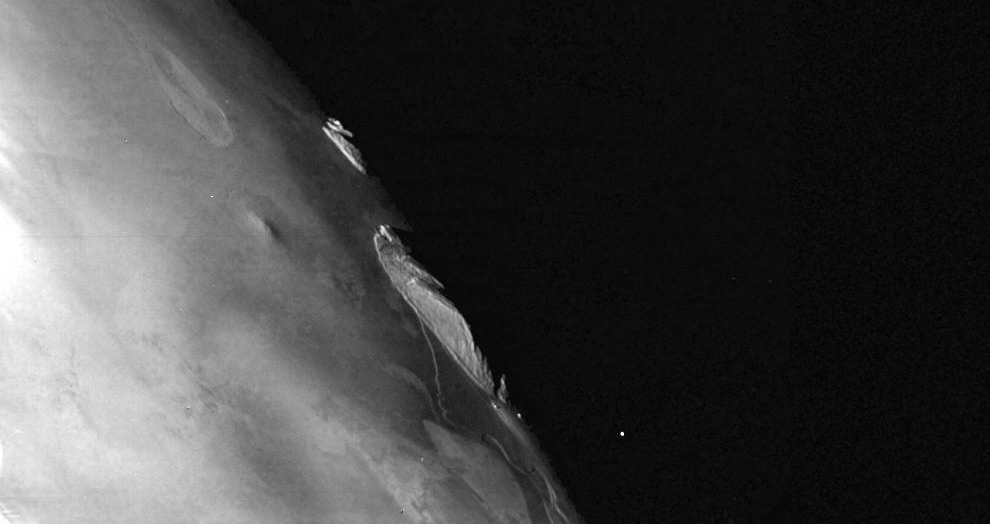
A part of the southern hemisphere of Io, seen by the spacecraft Voyager at a range of 74,675 km. In the foreground is gently undulating topography, while in the back-ground are two mountains with their near faces brightly illuminated by the sun. The mountain in the right is approximately 150 km across at its base and its height is probably in excess of 15 km which would make it higher than any mountain on Earth. (NASA/JPL)
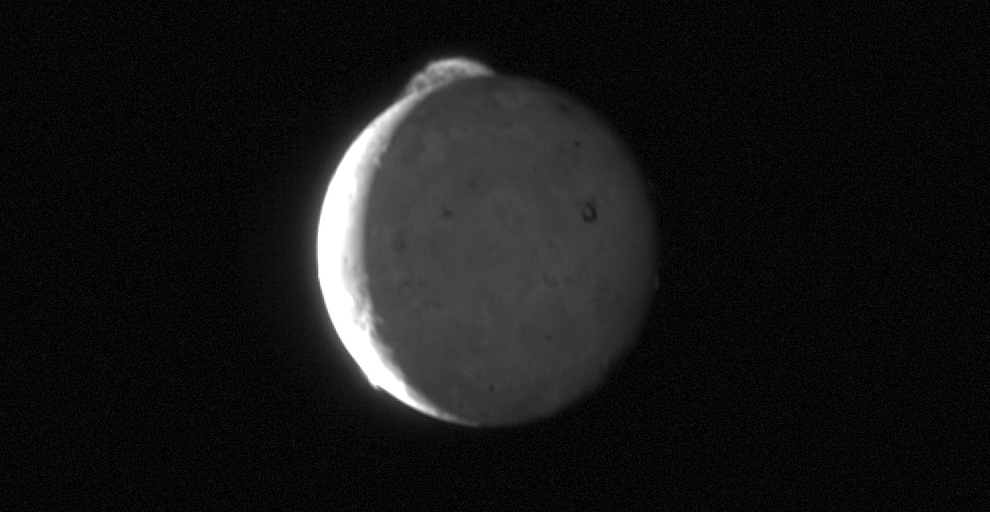
This five-frame sequence of New Horizons images captures the giant plume from Io's Tvashtar volcano. Snapped by the probe's Long Range Reconnaissance Imager (LORRI) as the spacecraft flew past Jupiter earlier this year, this first-ever "movie" of an Io plume clearly shows motion in the cloud of volcanic debris, which extends 330 kilometers (200 miles) above the moon's surface. Only the upper part of the plume is visible from this vantage point - the plume's source is 130 kilometers (80 miles) below the edge of Io's disk, on the far side of the moon. (NASA/Johns Hopkins University Applied Physics Laboratory/Southwest Research Institute)
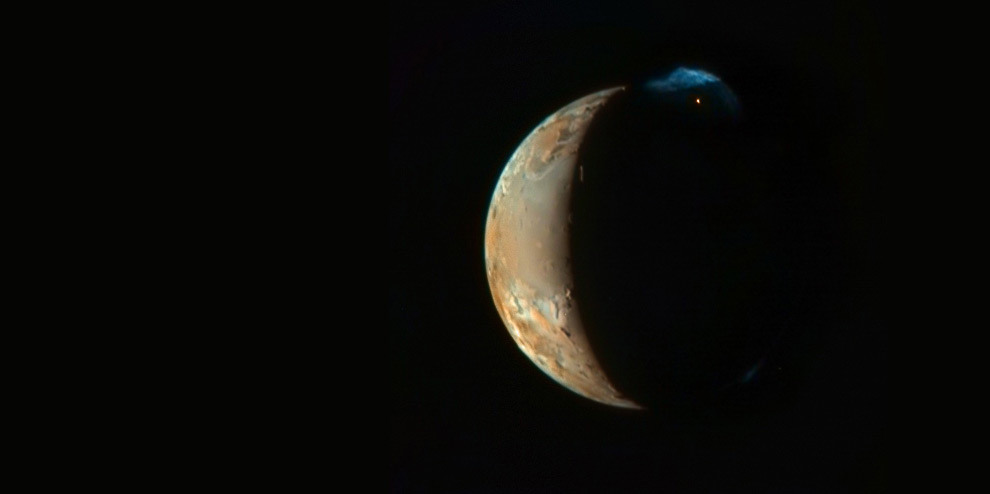
A volcanic plume rises over 300 kilometers above the horizon of Jupiter's moon Io in this image from cameras onboard the New Horizons spacecraft. The volcano, Tvashtar, is marked by the bright glow (about 1 o'clock) at the moon's edge, beyond the terminator or night/day shadow line. The shadow of Io cuts across the plume itself. Also capturing stunning details on the dayside surface, the high resolution image was recorded when the spacecraft was 2.3 million kilometers from Io. Later it was combined with lower resolution color data by astro-imager Sean Walker to produce this sharp portrait of the solar system's most active moon. (NASA, JHU/APL, SwRI - Additional Processing: Sean Walker)
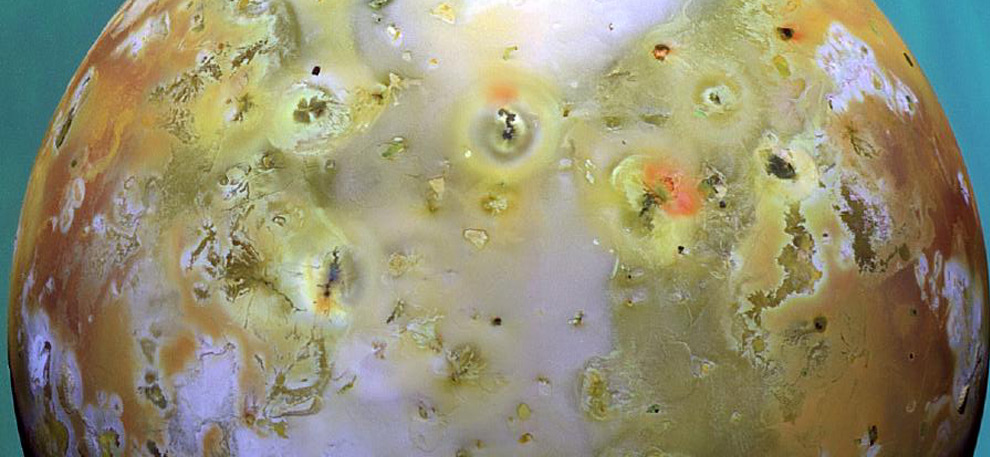
Jupiter's moon Io, seen by NASA's Galileo spacecraft against a backdrop of Jupiter's cloud tops, which appear blue in this false-color composite. (NASA/JPL/University of Arizona)
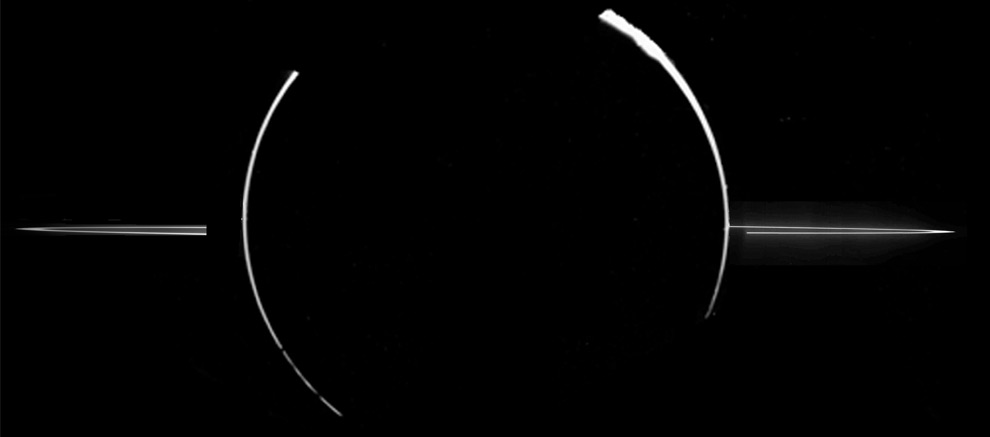
A mosaic of Jupiter's ring system, acquired by NASA's Galileo spacecraft when the Sun was behind the planet, and the spacecraft was in Jupiter's shadow peering back toward the Sun. (NASA/JPL/Cornell University)

The first color movie of Jupiter from NASA's Cassini spacecraft shows what it would look like to peel the entire globe of Jupiter, stretch it out on a wall into the form of a rectangular map, and watch its atmosphere evolve with time. The brief movie clip spans 24 Jupiter rotations between Oct. 31 and Nov. 9, 2000. The darker blips that appear are several moons and their shadows. (NASA/JPL/University of Arizona)
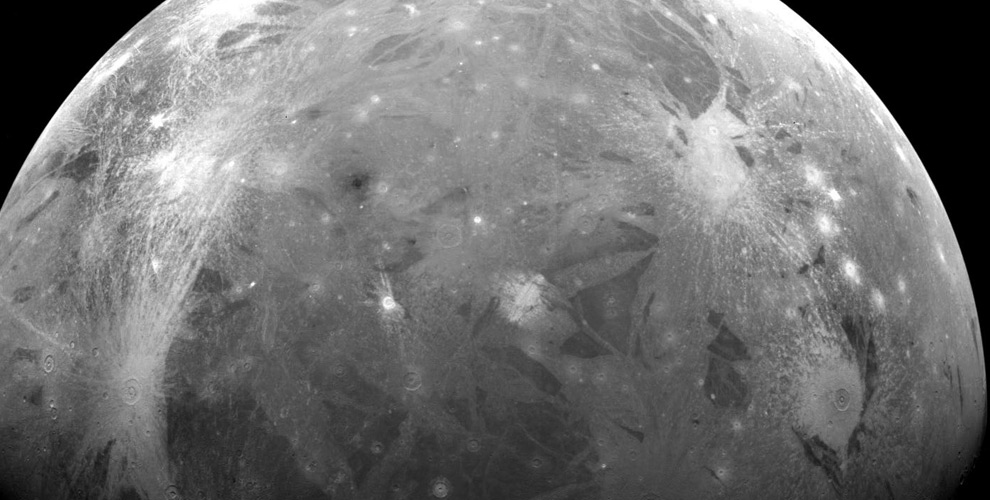
An image of the leading hemisphere of Ganymede seen by NASA's Galileo spacecraft. Many fragmented regions of dark terrain split by lanes of bright grooved terrain cover the surface. Several bright young craters can be seen, including a linear chain of craters near the center of the image which may have resulted from the impact of a fragmented comet, similar to comet Shoemaker-Levy/9 which hit Jupiter in 1994. (NASA/JPL/Brown University)
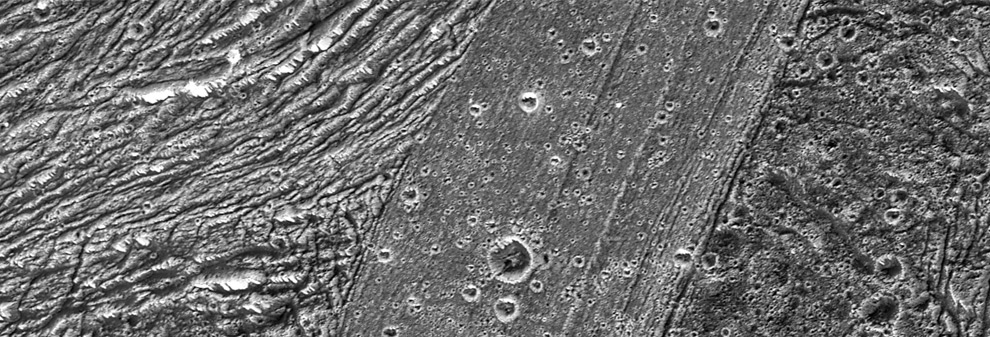
The area of Nicholson Regio and Arbela Sulcus illustrates many of the diverse terrain types on Jupiter's moon Ganymede, as seen in this image taken by NASA's Galileo spacecraft. The image covers an area approximately 89 by 26 kilometers (55by 16 miles). (NASA/JPL/Brown University)

Jupiter's Great Red seen by NASA's Voyager spacecraft. July, 1979 Around the northern boundary a white cloud is seen, which extends to east of the region. The presence of this cloud prevents small cloud vortices from circling the spot in the manner seen in the Voyager 1 encounter. Another white oval cloud (different from the one present in this position three months ago) is seen south of the Great Red Spot. This image was taken on July 6, 1979 from a range of 2,633,003 kilometers. The Red Spot is 20,000 km across. (NASA/JPL)

This true color mosaic of Jupiter was constructed from images taken by the narrow angle camera onboard NASA's Cassini spacecraft on December 29, 2000, as the spacecraft neared Jupiter during its flyby of the giant planet. It is the most detailed global color portrait of Jupiter ever produced. Although Cassini's camera can see more colors than humans can, Jupiter here looks the way that the human eye would see it. (NASA/JPL/SSI)

No comments:
Post a Comment